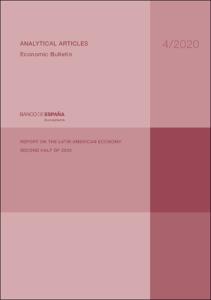Registro completo de metadatos
| Campo DC | Valor |
|---|---|
| dc.contributor.author | Banco de España. Departamento de Economía Internacional y Área del Euro |
| dc.coverage.spatial | América Latina |
| dc.date.accessioned | 2020-10-09T19:11:55Z |
| dc.date.available | 2020-10-09T19:11:55Z |
| dc.date.issued | 2020-10-08 |
| dc.identifier.uri | https://repositorio.bde.es/handle/123456789/13928 |
| dc.description | Artículo de revista |
| dc.description.abstract | Economic activity in Latin America has been drastically affected by the COVID-19 global health crisis, although this has been partly mitigated by economic policy actions taken by national authorities and multilateral institutions. As in other parts of the world, these actions have, in many cases, included new measures, with respect to previous crises, such as, for the first time in the region, the widespread use of unconventional monetary policy instruments. Despite these actions, Latin America may record a drop in GDP of close to 8% in 2020, the largest in recent decades and notably larger than those in other emerging regions. In recent months, despite less support from international capital flows than in previous recoveries, activity has started to recover. This is expected to continue in the short term, although the recovery will be uneven across economies, gradual and subject to a high degree of uncertainty. In the medium term, the region’s growth outlook is also subject to considerable uncertainty, mainly linked to the doubts regarding the future course of the pandemic. Generally, downside risks predominate, given that the region’s pre-existing vulnerabilities may be amplified by the persistence of the crisis. The area’s banking systems have also been hit by the economic deterioration, but have displayed notable resilience in this first phase of the crisis. From the economic policy viewpoint, this scenario should lead to the design and implementation of a broad medium-term reform agenda, to increase the region’s resilience and raise its potential growth capacity, while being conducive to the correction of the main macroeconomic and social imbalances. |
| dc.format.extent | 34 p. |
| dc.language.iso | en |
| dc.publisher | Banco de España |
| dc.relation.ispartof | Economic Bulletin / Banco de España, 4/2020 |
| dc.relation.hasversion | Versión en español 123456789/13930 |
| dc.rights | Reconocimiento-NoComercial-CompartirIgual 4.0 Internacional (CC BY-NC-SA 4.0) |
| dc.rights | In Copyright - Non Commercial Use Permitted |
| dc.rights.uri | https://creativecommons.org/licenses/by-nc-sa/4.0/deed.es_ES |
| dc.rights.uri | http://rightsstatements.org/vocab/InC-NC/1.0/ |
| dc.subject | Epidemiological developments |
| dc.subject | Mobility and activity restrictions |
| dc.subject | Economic vulnerabilities |
| dc.subject | Financial asset purchase programmes |
| dc.subject | Government debt restructuring |
| dc.subject | Monetary and fiscal space |
| dc.subject | Financial system |
| dc.subject | Labour informality |
| dc.subject | Uncertainty in economic forecasts |
| dc.subject | International economy |
| dc.subject | International economy |
| dc.title | Report on the Latin American economy. Second half of 2020 |
| dc.type | Artículo |
| dc.identifier.bdebib | 000470497 |
| dc.identifier.bdepub | ECBU-2020-4B-art31 |
| dc.subject.bde | Evolución y desarrollo económicos |
| dc.publisher.bde | Madrid : Banco de España, 2020 |
| dc.subject.jel | F01 |
| dc.subject.jel | F24 |
| dc.subject.jel | F30 |
| dc.subject.jel | F47 |












